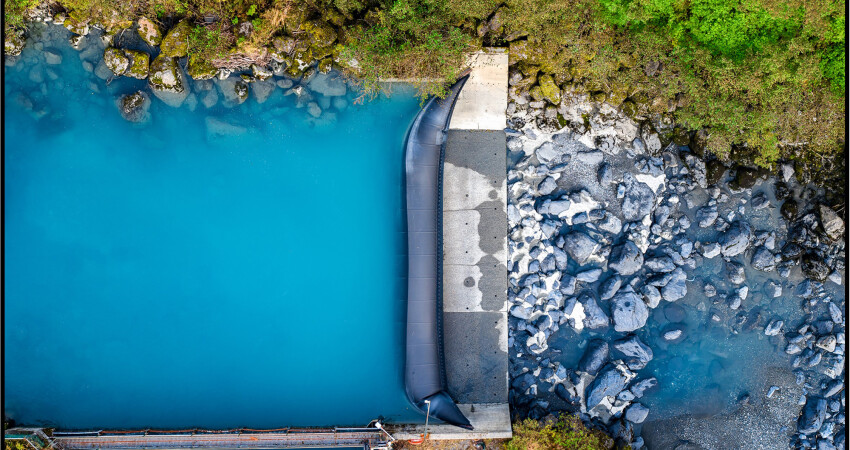A hydroelectric dam in Alaska's Prince William Sound provides approximately 70% of electric power for the isolated fishing community of Cordova, while waters rushing through the Power Creek dam also are managed to protect spawning habitat for the region's robust wild salmon run.
Harvests of the region's famed Copper River kings and reds, beginning in late May of 2025, along with coho, chum, and pink salmon, depend on healthy spawning grounds. Salmon benefit from routine summer maintenance of the Power Creek dam, which consists mainly of a giant inflatable bladder that can be lowered to let the river return to its natural course.
"As sand and sticks accumulate in the intake structure over time, we want to flush it out periodically," said Clay Koplin, chief executive officer of the Cordova Electric Cooperative. "We start a diesel generator in town. We take all the load onto the diesel. We turn the hydro plant off and that stops the water flowing through her and then we deflate the bladder, and we just let the river go back to its natural course."
Once the water is flushed for 10-15 minutes the bladder is inflated again and hydropower is started back up. Meanwhile the river has passively cleaned itself.
"The way the dam operates is it can release all the water and flush all the gravel and sediment down into the creek bed to kind of mimic the natural source of how the sediment would move through the water system and totally minimize the effects on salmon spawning," opines Rita Spann, in the YouTube video “Powering Cordova: Part 2” that provides a visual tour of the project. "That obviously works because it's a very lucrative salmon spawning stream."
In an average year Power Creek provides 65-70% of the community's electric power and Humpback Creek 10-15%, said Koplin, a professional electrical engineer. "Just to put that in perspective financially, it cost $24 million to build this entire project, the intake and the pipeline and the power plant and everything, the road, access roads. Both projects were designed to have the least impact on the spawning area. In its first 20 years of operation, it has already saved over $50 million in diesel fuel alone”.
"Cordova wouldn't have the seafood industry it has today without hydropower," he said.

Rich Wheeler, owner/operator with his wife Sena of 60° North Seafoods in Cordova, said he is amazed at what Cordova is able to offer in hydropower. "If we didn't have hydropower the cost of diesel power generators would go through the roof," Wheeler said. "If it wasn't for the inexpensive hydropower the cost of diesel power would put us all out of business."
The environmental impact of hydropower is also important for Cordova, noted Kristen Smith, executive director of the Prince William Sound Economic Development District, as well as the recently elected mayor of Cordova. "Any reduction in burning diesel fuel is an improvement in air quality, for our residents and in reduced greenhouse gas emissions."
"It has been a pretty simple formula; invested federal and state funding in the high up-front cost of building the hydro plants, and the community benefits from low-cost power for the next 100 years," Koplin said. "This is why many of the Southeast Alaska utilities have some of the lowest rates in the state - they are mostly hydropower by projects that have the debt paid off."
On March 27, Sens. Lisa Murkowski, R-AK, and Maria Cantwell, D-WA., announced that they have reintroduced their Maintaining and Enhancing Hydroelectricity and River Restoration Act, which supports hydroelectricity infrastructure development via a federal tax incentive to increase security and capacity of existing dams.
“Federal support is critical to assist with the initial high capital costs of developing hydropower, which becomes our most secure and affordable energy option for future generations,” Koplin said.
"In the past, hydro has not had very much access to federal funding," Koplin said. "However, the past two administrations have increasingly funded hydropower through tax credits, low interest loans, and grants. Senator Murkowski has been instrumental in these opportunities."
The legislation would establish a 30% federal tax incentive to encourage upgrades to the safety and security of existing dams, investments that expand fish passage infrastructure, and improvements to water quality and recreational use opportunities at the hydropower project sites.
It would also establish a first-ever federal cost-share to encourage removal of obsolete obstructions that harm river ecosystems and outdoor recreation opportunities.
CEC is currently working on the development of the two storage projects. "Humpback Creek dam and Crater Lake Dam. Power Creek and Humpback Creek are both run-of-river; there is no dam storage, so we must use the water for electricity or lose it", Koplin said.
In the summer CEC spills a lot of excess water, and in the winter, CEC must run diesels.
"With dams we can fill them up when we have more water than we need and then run the projects when we don't to get rid of our remaining diesel," he said.
Both projects would benefit from this legislation reintroduced by Murkowski and Cantwell, particularly with investment and production tax credits that Murkowski has worked to make available to tax-exempt public power utilities like most of those in Alaska — electric cooperatives and municipal utilities.







